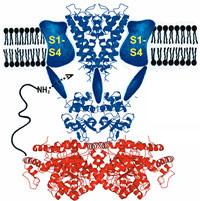Electrical door of the cell
2001/06/08 Galarraga Aiestaran, Ana - Elhuyar Zientzia
Over the past 50 years, researchers have studied this cellular mechanism that generates electrical impulses. In 1970 a channel closure model was proposed. According to this model, the channel is closed by a plug that goes up and down the channel. Now, researcher Mac Kinnon and his team at the University of New York have released the results of the study on the mechanism.

In the work published in the journal Nature, Mac Kinnon uses the image of the snake inside the channel instead of the plug. The cell membrane is fat and moves to locate the "snake" in the center of the channel. The researchers systematically modified the parts of the ion channel of a bacterium to determine the part that controlled this function.
In addition, the molecules that had the appearance of “snake” also saw the hole close well. This knowledge will allow to design new drugs. In fact, there are already medications that work on ionic channels, such as some anesthetics or medications used to control irregular heartbeat.
The knowledge of the structure of ion channels gave them a great job, since to clean and analyze the fat membranes with detergent they had to collect proteins. They finally obtained a transformed bacterium capable of producing many channels, which allowed them to study the structure. Despite the importance of the step taken, from now on they intend to investigate the ion channels of mammal cells.

Gai honi buruzko eduki gehiago
Elhuyarrek garatutako teknologia




